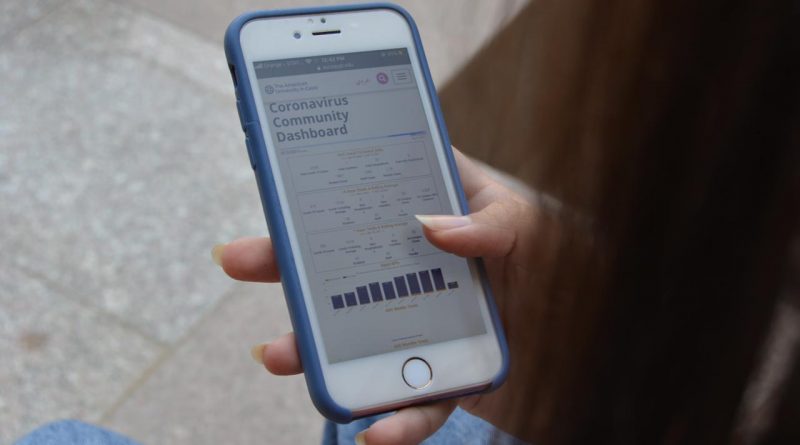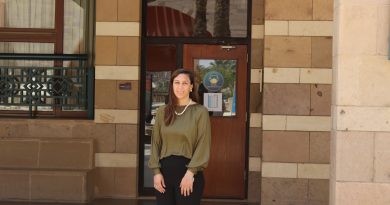‘AUC Covid-19 Dashboard’: Everything you need to know
By: Martina Muawad
@martinamichelcx
Checking the AUC Coronavirus Community Dashboard has become a daily ritual for AUC students, faculty and staff since the full return to campus.
The dashboard was implemented in late 2020 to give the community a better view of the progression of the coronavirus on campus and nationally. It includes data like the total number of cases, total fatalities, total hospitalized, and student, staff, and faculty cases.
Hassan Azzazy, Chair of the Department of Chemistry, who is a member of the AUC Scientific Advisors Committee, told The Caravan that the dashboard looks at a rolling average over a seven-day period: this means that it sees how many new cases have been reported over the past seven days, and then divides that number by 7 to produce the average.
“It’s like a rolling window. Tomorrow, for example, the window moves one day to include yesterday and then counts how many cases for the past seven days. Therefore, you always see the average of the past seven days. The window keeps moving and therefore it is called the rolling average,” said Azzazy.
On November 7, the dashboard introduced the 14-day rolling average as well.
Looking at a 14-day rolling average is only a bigger window. So instead of calculating over seven days and dividing by seven, it calculates the past 14 days – moving one day at a time – and dividing by 14.
Azzazy said that introducing the 14-day rolling average is in tandem with the new four-stage guidelines AUC is adopting from the Minnesota Department of Health, as previously reported in The Caravan’s October 17 issue.
“The four-stage approach gives us a more realistic [perspective]. It takes into consideration multiple parameters, not only of new cases, but also takes into consideration what the country is doing and the dashboard of Egypt according to the Ministry of Health,” Azzazy said.
The dashboard also looks at the university’s local resources such as the clinic, contact tracing, and antigen testing, and indicates whether AUC is able to cope.
“It also takes into consideration the absenteeism amongst the faculty and staff at AUC,” he added.
In a November 4 email update to the community on AUC’s campus safety measures, Provost Ehab Abdelrahman said that in case the 14-day rolling average surpassed 21 cases (up from the previous threshold of 15), the university would move classes online for a period of two weeks. Classes with strong justification to run face to face would be exempt and therefore remain on campus.
Azzazy says that the old threshold at 15 was only a “guesstimate” to indicate when things got out of hand rather than an accurate value.
“We did not have vaccines. We did not know how the pandemic was moving and we were missing many parameters [at the time the 15 figure was determined],” Azzazy said.
But now, in addition to adopting the Minnesotan approach that is recommended especially for institutions of higher education, Azzazy pointed to the university’s safety measures of mandatory wearing of face masks, social distancing, cleaning surfaces frequently, and diagnostic testing for any symptomatic member of AUC.
“All contacts of a positive case also get tested and monitored. This is called ‘Screening Testing’. We also do ‘Surveillance Testing’ which is for people who are not vaccinated because of having an underlying condition. And then, we have over 90% of our AUC body vaccinated,” Azzazy told The Caravan.
The US-based Center for Disease Control and Prevention (CDC) says that “COVID 19-vaccines are effective and can reduce the risk of getting and spreading the virus that causes”.
Azzazy concurs, adding that while the vaccines do not make someone immune or prevent viral transmission to others, they do reduce the risks of transmission as well as the consequences of contracting the virus.
He went on to explain that the Scientific Advisors Committee had been promoting a series of flowcharts which depicted three different scenarios for dealing with COVID-19 situations on campus.
The first scenario provides guidance to faculty if they discover an ill student; the second guides the community on what to do if they come into contact with a positive case; and finally, what community members should do if they receive a ‘red face’ after filling out and submitting the self-check form.
Each scenario tells students and professors how to manage the situation effectively.
Last week, the dashboard reported that there had been three fatalities over a one-week period but Azzazy says that it was due to a technical glitch and quickly corrected back to one.
“I do not know what exactly happened. I was told it was just a technical glitch. We would have known if someone died and was a fatality. If it was a student, the professors must be informed. If it was faculty, it would be worse, everyone would know since classes would be cancelled and so on. And if it was a staff member, although it is the easiest to hide, professors who see staff daily would notice and know. We have no evidence of anything other than that it was a technical glitch,” Azzazy explained.
The Scientific Advisors Committee does not have the authority to investigate COVID-related issues, Azzazy said. The mandate of the committee is to advise the university on what measures are best to combat Covid-19.
“AUC administration may take or disregard the recommendations.”




